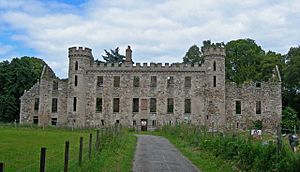Fetternear Palace facts for kids
Fetternear Bishop's Palace is an old archaeological site. It was once a home for the important medieval bishops of Aberdeen. You can find it near Kemnay in Aberdeenshire. Later, a ruined tower-house and a mansion called Fetternear House were built on part of this same spot.
Where Was the Bishop's Palace?
The bishop's palace at Fetternear was in its own special area long ago. This area was called a parish. Later, this parish joined with another one called Chapel of Garioch.
The palace itself was on a sloped area. It was above a small stream called the Marshes Burn, close to where it meets the River Don. This is right across from Kemnay. Experts think the first part of the name, Fetter-, comes from an old word meaning "shelving" or "terraced land." This makes sense because of the sloped ground. However, no one is sure what the –near part of the name means.
Discovering the Bishop's Palace
A historian named H. Gordon Slade once wrote about the later mansion at Fetternear. He noticed that very little of the old bishop's palace could be seen above ground. He thought that maybe the foundations were from a tower shaped like the letter "L". Slade's writings mostly focused on the mansion built after the Scottish Reformation in 1560. This was when the church in Scotland changed a lot. The Leslie family got the land after this time.
Because not much was known about the medieval bishop's palace, two researchers started a project. Nicholas Bogdan and Penelope (Penny) Dransart began the Scottish Episcopal Palaces Project (SEPP) in 1995. Their goal was to learn how Scottish bishops' homes were built and changed over time. They wanted to see how these homes helped bishops visit different parts of their church areas. So far, they have focused on Fetternear and another site called Kinneddar.
What Did Excavations Find?
The SEPP team dug up parts of Fetternear. They found that the old foundations Slade saw had been changed a lot in the late 1800s. This happened after someone dug up parts of the palace that were under the mansion's lawns. An architect named William Kelly saw some beautiful carved stones from these digs in the early 1900s. He said they were very well made.
The SEPP team also discovered that the medieval bishop's palace was mostly surrounded by a moat. This was like a ditch filled with water. It's likely that the first palace was made of wood. It sat on a raised area inside this moat. The water from the moat flowed into the Marshes Burn. In 2006, they found proof of a wooden fence, called an oak palisade. This fence was inside the moat, around the palace buildings.
The main entrance to the palace was from the southeast. Visitors would have crossed a wooden bridge to get in. In 2009, they even found a part of this bridge. During their digs in 2005 and 2006, the team also explored the kitchen area. This was in the southwest corner of the palace.
In 2010, they found parts of the south and east walls of a stone chapel. This chapel was a short distance south of the tower-house. When visitors crossed the wooden bridge into the palace, they would have turned right to enter the chapel.
The year 2010 was the last time SEPP dug at Fetternear. Since then, the project has been studying all the things they found. They are also looking at old documents about the site's history. They have even walked around the nearby fields to look for more clues.
In 2013, there was an exhibition about Fetternear. It was called 'Light Divine: Church and Chapel Windows at Fetternear, Aberdeenshire'. This show focused on the windows from the palace's chapel and other Christian buildings on the estate. It showed the different types of window glass used and other glass items found during the excavations.


